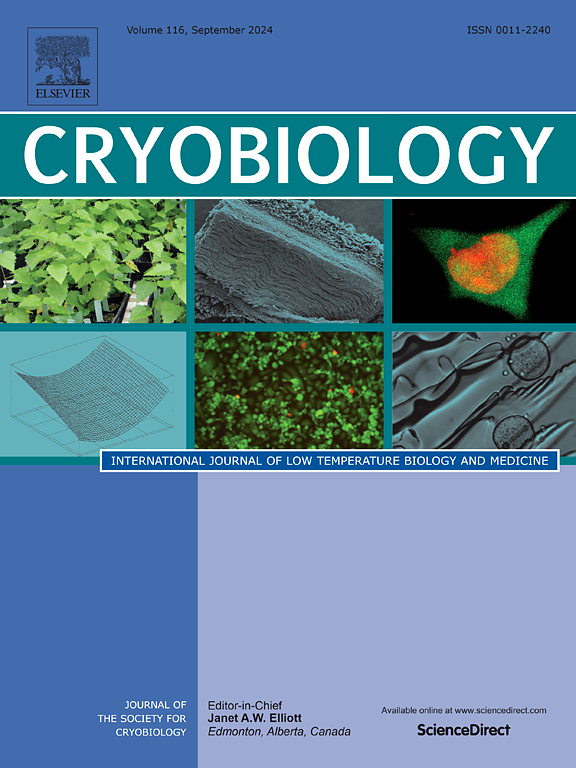Effect of temperature on acute kidney injury in a rat model of renal ischemia‒reperfusion
IF 2.3
3区 生物学
Q2 BIOLOGY
引用次数: 0
Abstract
Renal ischemia-reperfusion (I/R) injury is the main cause of acute kidney injury (AKI). A reliable and stable animal model is crucial for experimental research. Various factors affect the stability of animal models. In the present study, the effect of intraoperative temperature on the establishment of AKI model in rats, induced by I/R through bilateral renal pedicles clamping via the dorsal approach surgery, was investigated. Forty-eight male Sprague Dawley rats of 8–10 weeks were randomly divided into 6 groups (8 per group). The renal ischemia-reperfusion injury model was induced using a retroperitoneal double pedicle clamp procedure, using a clamping time of 50 min. The modeling procedure and sham operation were performed at different ambient air temperature, i.e., 15–20 °C, 20–25 °C and 25–30 °C. The general state of the rats, the ascites volume and mortality were observed after the operation. The serum creatinine (Scr) and urea nitrogen (BUN) levels of rats in each group were measured by an automatic biochemical analyzer 24 h post-operation. HE staining was used to observe pathological changes in renal tissues, and NF-κB p65 and interleukin-6 (IL-6) expression was measured by immunohistochemistry (IHC). TUNEL staining was used to assess apoptosis in renal tissues, and the expression of inflammatory markers, such as NF-κB and IL-6, and the apoptosis-related protein Bax was measured by Western blotting. There were no significant differences among the different sham operation groups. However, the abovementioned parameters were greater in the hypothermia, normothermia and hyperthermia model groups than in the corresponding sham operation groups, indicating successful model establishment. Scr and BUN levels were greater in the hyperthermia model group than in the other model groups, and there was obvious pathological damage to renal tissue. Notably, in the hypothermia model group, the general state of rats was good, Scr and BUN levels were not significantly increased 24 h post-operation, pathological damage to renal tissue and renal tubular epithelial cell apoptosis were mild, NF-κB and IL-6 protein expression was increased, and Bax protein expression was decreased. In conclusion, the induction of AKI by I/R at 20–25 °C has a high successful modeling rate and a low mortality rate. It may affect the stability of animal models by down-regulating the NF-κB/IL-6 signaling pathway and the NF-κB/Bax pathway through its anti-apoptotic and anti-inflammatory effects.
温度对大鼠肾缺血再灌注模型急性肾损伤的影响
肾缺血再灌注(I/R)损伤是急性肾损伤(AKI)的主要原因。可靠稳定的动物模型对实验研究至关重要。多种因素影响动物模型的稳定性。本研究探讨术中温度对经背侧入路双侧肾蒂夹持I/R大鼠AKI模型建立的影响。48只8 ~ 10周龄雄性sd大鼠随机分为6组,每组8只。采用腹膜后双蒂夹持法建立肾缺血再灌注损伤模型,夹持时间为50 min。造模过程和假手术分别在15-20℃、20-25℃和25-30℃环境空气温度下进行。观察术后大鼠一般状态、腹水量及死亡率。术后24 h,采用全自动生化分析仪测定各组大鼠血清肌酐(Scr)和尿素氮(BUN)水平。HE染色观察肾组织病理变化,免疫组化(IHC)检测NF-κB p65、白细胞介素-6 (IL-6)表达。TUNEL染色检测肾组织凋亡,Western blotting检测NF-κB、IL-6等炎症标志物及凋亡相关蛋白Bax的表达。不同假手术组间差异无统计学意义。但亚低温、常温、高温模型组上述参数均大于假手术组,说明模型建立成功。热疗模型组大鼠Scr、BUN水平明显高于其他模型组,肾组织有明显的病理损伤。值得注意的是,低温模型组大鼠总体状态良好,术后24 h Scr、BUN水平无明显升高,肾组织病理损伤及肾小管上皮细胞凋亡轻微,NF-κB、IL-6蛋白表达升高,Bax蛋白表达降低。综上所述,20 ~ 25℃I/R诱导AKI的建模成功率高,死亡率低。它可能通过其抗凋亡和抗炎作用下调NF-κB/IL-6信号通路和NF-κB/Bax通路,从而影响动物模型的稳定性。
本文章由计算机程序翻译,如有差异,请以英文原文为准。
求助全文
约1分钟内获得全文
求助全文
来源期刊

Cryobiology
生物-生理学
CiteScore
5.40
自引率
7.40%
发文量
71
审稿时长
56 days
期刊介绍:
Cryobiology: International Journal of Low Temperature Biology and Medicine publishes research articles on all aspects of low temperature biology and medicine.
Research Areas include:
• Cryoprotective additives and their pharmacological actions
• Cryosurgery
• Freeze-drying
• Freezing
• Frost hardiness in plants
• Hibernation
• Hypothermia
• Medical applications of reduced temperature
• Perfusion of organs
• All pertinent methodologies
Cryobiology is the official journal of the Society for Cryobiology.
 求助内容:
求助内容: 应助结果提醒方式:
应助结果提醒方式:


